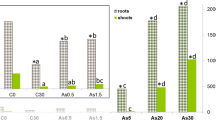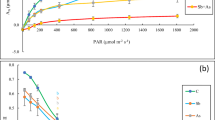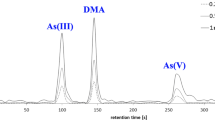Abstract
Purpose
This study delineated the effect of calcium (Ca) and ethylenediaminetetraacetic acid (EDTA) addition on arsenic (As) accumulation and physiological attributes of Vicia faba L.
Materials and methods
Two separate experiments were performed. In the first experiment, V. faba seedlings, grown under hydroponic conditions, were exposed to three levels of As (25, 125 and 250 μM) in the presence and absence of three levels of EDTA (25, 125, 250 μM) and calcium (CaCl2: 1, 5 and 10 mM). The effect of EDTA and Ca on As accumulation and physiological attributes of V. faba was assessed by determining As contents in roots and shoot, chlorophyll contents, H2O2 contents, and lipid peroxidation in young and old leaves. In the second experiment, V. faba seeds were grown in As-contaminated sand culture using the same treatment plan.
Results and discussion
The accumulation and toxicity of As to V. faba plants increased with increasing As levels in nutrient solution. Arsenic exposure enhanced the production of reactive oxygen species (ROS) in both roots and leaves, which resulted in lipid peroxidation and decreased chlorophyll contents. The presence of both EDTA and Ca, in general, significantly decreased As accumulation by V. faba seedlings, Ca being more effective than EDTA. Both the amendments decreased As-induced reactive oxygen species (ROS) production and lipid peroxidation. In the case of chlorophyll contents, EDTA significantly decreased chlorophyll contents, while Ca significantly increased chlorophyll contents compared to As. The effect of all the treatments was more pronounced in roots than leaves and in young leaves compared to old leaves.
Conclusions
It is proposed that EDTA and Ca greatly affect As accumulation and toxicity to V. faba, and the effect varies greatly with their applied levels as well as type and age of plant organs. The germinating seedlings of V. faba may be preferred for risk assessment studies, while transplanting 1-week-old V. faba seedlings to As-contaminated soils can decrease its toxicity.


Similar content being viewed by others
References
Abdul KSM, Jayasinghe SS, Chandana EP, Jayasumana C, De Silva PMC (2015) Arsenic and human health effects: a review. Environ Toxicol Pharmacol 40:828–846
Armendariz AL, Talano MA, Travaglia C, Reinoso H, Oller ALW, Agostini E (2016) Arsenic toxicity in soybean seedlings and their attenuation mechanisms. Plant Physiol Biochem 98:119–127
Austruy A, Shahid M, Xiong T, Castrec M, Payre V, Niazi NK, Sabir M, Dumat C (2014) Mechanisms of metal-phosphates formation in the rhizosphere soils of pea and tomato: environmental and sanitary consequences. J Soils Sediments 14:666–678
Chen X, Yang L, Zhang J, Huang Y (2014) Exploration of As (III)/As (V) uptake from aqueous solution by synthesized calcium sulfate whisker. Chin J Chem Eng 22:1340–1346
Chou M-L, Jean J-S, Yang C-M, Hseu Z-Y, Chen Y-H, Wang H-L, Das S, Chou L-S (2016) Inhibition of ethylenediaminetetraacetic acid ferric sodium salt (EDTA-Fe) and calcium peroxide (CaO 2) on arsenic uptake by vegetables in arsenic-rich agricultural soil. J Geochem Explor 163:19–27
Chuan-Ping L, Chang-An W, Fang-Bai L (2010) The use of calcium peroxide (CaO2) as a process applied to arsenic contaminated soil around an abandoned tungsten mine, southern China, 19th World Congress of Soil Science: Soil solutions for a changing world, Brisbane, Australia, 1–6 August 2010. International Union of Soil Sciences (IUSS), Universität für Bodenkultur, pp 256–259
Finnegan P, Chen W (2012) Arsenic toxicity: the effects on plant metabolism. Front Physiol 3:182
Flora SJ (2011) Arsenic-induced oxidative stress and its reversibility. Free Radic Biol Med 51:257–281
Foucault Y, Lévêque T, Xiong T, Schreck E, Austruy A, Shahid M, Dumat C (2013) Green manure plants for remediation of soils polluted by metals and metalloids: Ecotoxicity and human bioavailability assessment. Chemosphere 93:1430–1435
Gong X, Ivanov VN, Davidson MM, Hei TK (2015) Tetramethylpyrazine (TMP) protects against sodium arsenite-induced nephrotoxicity by suppressing ROS production, mitochondrial dysfunction, pro-inflammatory signaling pathways and programed cell death. Arch Toxicol 89:1057–1070
Grčman H, Velikonja-Bolta Š, Vodnik D, Kos B, Leštan D (2001) EDTA enhanced heavy metal phytoextraction: metal accumulation, leaching and toxicity. Plant Soil 235:105–114
Gulz PA, Gupta S-K, Schulin R (2005) Arsenic accumulation of common plants from contaminated soils. Plant Soil 272:337–347
Hassan A, Abdel-Mohsen A, Elhadidy H (2014) Adsorption of arsenic by activated carbon, calcium alginate and their composite beads. Int J Biol Macromol 68:125–130
Hodges DM, DeLong JM, Forney CF, Prange RK (1999) Improving the thiobarbituric acid-reactive-substances assay for estimating lipid peroxidation in plant tissues containing anthocyanin and other interfering compounds. Planta 207:604–611
Islam E, Liu D, Li T, Yang X, Jin X, Mahmood Q, Tian S, Li J (2008) Effect of Pb toxicity on leaf growth, physiology and ultrastructure in the two ecotypes of Elsholtzia argyi. J Hazard Mater 154:914–926
Khalid S, Shahid M, Niazi NK, Rafiq M, Bakhat HF, Imran M, Abbas T, Bibi I, Dumat C (2016) Arsenic behaviour in soil-plant system: Biogeochemical reactions and chemical speciation influences. In: Anjum NA, Gill SS, Tuteja N (eds) Enhancing cleanup of environmental pollutants. Springer International Publishing AG. doi:10.1007/978-3-319-55423-5_4
Li N, Wang J, Song W-Y (2016) Arsenic uptake and translocation in plants. Plant Cell Physiol 57:4–13
Lichtenthaler HK (1987) [34] Chlorophylls and carotenoids: pigments of photosynthetic biomembranes. Plant Cell Membranes 148:350–382
Liu J, Zhou Q, Wang S (2010) Evaluation of chemical enhancement on phytoremediation effect of Cd-contaminated soils with Calendula officinalis L. Int J Phytoremediation 12:503–515
Luo C, Shen Z, Li X, Baker AJ (2006) Enhanced phytoextraction of Pb and other metals from artificially contaminated soils through the combined application of EDTA and EDDS. Chemosphere 63:1773–1784
Martínez-Toledo Á, Montes-Rocha A, González-Mille DJ, Espinosa-Reyes G, Torres-Dosal A, Mejia-Saavedra JJ, Ilizaliturri-Hernández CA (2017) Evaluation of enzyme activities in long-term polluted soils with mine tailing deposits of San Luis Potosí, México. J Soils Sediments 17:364–375
Mokgalaka-Matlala NS, Flores-Tavizón E, Castillo-Michel H, Peralta-Videa JR, Gardea-Torresdey JL (2008) Toxicity of arsenic (III) and (V) on plant growth, element uptake, and total amylolytic activity of mesquite (Prosopis juliflora x P. velutina). Int J Phytoremediation 10:47–60
Naujokas MF, Anderson B, Ahsan H, Aposhian HV, Graziano JH, Thompson C, Suk WA (2013) The broad scope of health effects from chronic arsenic exposure: update on a worldwide public health problem. Environ Health Perspect 121:295–302
Niazi NK, Bishop TF, Singh B (2011) Evaluation of spatial variability of soil arsenic adjacent to a disused cattle-dip site, using model-based geostatistics. Environ Sci Technol 45:10463–10470
Rafiq M, Shahid M, Abbas G, Shamshad S, Khalid S, Niazi NK, Dumat C (2017) Comparative effect of calcium and EDTA on arsenic uptake and physiological attributes of Pisum sativum. Int J Phytoremediation. doi:10.1080/15226514.2016.1278426
Rahman A, Mostofa MG, Alam MM, Nahar K, Hasanuzzaman M, Fujita M (2015) Calcium mitigates arsenic toxicity in rice seedlings by reducing arsenic uptake and modulating the antioxidant defense and glyoxalase systems and stress markers. Biomed Res Int. doi:10.1155/2015/340812
Reed ST, Ayala-Silva T, Dunn CB, Gordon GG (2015) Effects of arsenic on nutrient accumulation and distribution in selected ornamental plants. Agr Sci 6:1513–1531
Rehman ZU, Khan S, Qin K, Brusseau ML, Shah MT, Din I (2016) Quantification of inorganic arsenic exposure and cancer risk via consumption of vegetables in southern selected districts of Pakistan. Sci Total Environ 550:321–329
Rosas-Castor J, Guzmán-Mar J, Hernández-Ramírez A, Garza-González M, Hinojosa-Reyes L (2014) Arsenic accumulation in maize crop (Zea mays): a review. Sci Total Environ 488:176–187
Saifullah SM, Shahid M, Zia-Ur-Rehman M, Sabir M, Ahmad HR (2015) Chapter 14 - phytoremediation of Pb-contaminated soils using synthetic chelates. In: Krhsör M (ed) Soil remediation and plants. Academic Press, San Diego, pp 397–414
Sanglard LM, Detmann KC, Martins SC, Teixeira RA, Pereira LF, Sanglard ML, Fernie AR, Araújo WL, DaMatta FM (2016) The role of silicon in metabolic acclimation of rice plants challenged with arsenic. Environ Exp Bot 123:22–36
Santos C, Rodriguez E (2012) Review on some emerging endpoints of chromium (VI) and lead phytotoxicity. INTECH Open Access Publisher. doi:10.5772/34919
Sarret G, Vangronsveld J, Manceau A, Musso M, D'Haen J, Menthonnex J-J, Hazemann J-L (2001) Accumulation forms of Zn and Pb in Phaseolus vulgaris in the presence and absence of EDTA. Environ Sci Technol 35:2854–2859
Shahid M, Pinelli E, Pourrut B, Silvestre J, Dumat C (2011) Lead-induced genotoxicity to Vicia faba L. roots in relation with metal cell uptake and initial speciation. Ecotoxicol Environ Saf 74:78–84
Shahid M, Pinelli E, Dumat C (2012) Review of Pb availability and toxicity to plants in relation with metal speciation; role of synthetic and natural organic ligands. J Hazard Mater 219-220:1–12
Shahid M, Austruy A, Echevarria G, Arshad M, Sanaullah M, Aslam M, Nadeem M, Nasim W, Dumat C (2014a) EDTA-enhanced phytoremediation of heavy metals: a review. Soil Sediment Contam: An International Journal 23:389–416
Shahid M, Dumat C, Pourrut B, Sabir M, Pinelli E (2014b) Assessing the effect of metal speciation on lead toxicity to Vicia faba pigment contents. J Geochem Explor 144:290–297
Shahid M, Dumat C, Pourrut B, Silvestre J, Laplanche C, Pinelli E (2014c) Influence of EDTA and citric acid on lead-induced oxidative stress to Vicia faba roots. J Soils Sediments 14:835–843
Shahid M, Pourrut B, Dumat C, Nadeem M, Aslam M, Pinelli E (2014d) Heavy-metal-induced reactive oxygen species: phytotoxicity and physicochemical changes in plants. Rev Environ Contam Toxicol 232:1–44
Shahid M, Dumat C, Pourrut B, Abbas G, Shahid N, Pinelli E (2015a) Role of metal speciation in lead-induced oxidative stress to Vicia faba roots. Russ J Plant Physiol 62:448–454
Shahid M, Khalid S, Abbas G, Shahid N, Nadeem M, Sabir M, Aslam M, Dumat C (2015b) Heavy metal stress and crop productivity. In: Hakeem KR (ed) Crop production and global environmental issues. Springer International Publishing, Switzerland, pp 1–25
Shahid M, Dumat C, Khalid S, Niazi NK, Antunes PM (2016) Cadmium bioavailability, uptake, toxicity and detoxification in soil-plant system. Rev Environ Contam Toxicol 241:73–137
Shakoor MB, Niazi NK, Bibi I, Rahman MM, Naidu R, Dong Z, Shahid M, Arshad M (2015) Unraveling health risk and speciation of arsenic from groundwater in rural areas of Punjab, Pakistan. Int J Environ Res Public Health 12:12371–12390
Shakoor MB, Niazi NK, Bibi I, Murtaza G, Kunhikrishnan A, Seshadri B, Shahid M, Ali S, Bolan NS, Ok YS (2016) Remediation of arsenic-contaminated water using agricultural wastes as biosorbents. Crit Rev Environ Sci Technol 46:467–499
Smith E, Juhasz A, Weber J (2009) Arsenic uptake and speciation in vegetables grown under greenhouse conditions. Environ Geochem Health 31:125–132
Xin J, Huang B, Yang Z, Yuan J, Zhang Y (2013) Comparison of cadmium subcellular distribution in different organs of two water spinach (Ipomoea aquatica Forsk.) cultivars. Plant Soil 372:431–444
Author information
Authors and Affiliations
Corresponding author
Additional information
Responsible editor: Jaume Bech
Rights and permissions
About this article
Cite this article
Rafiq, M., Shahid, M., Shamshad, S. et al. A comparative study to evaluate efficiency of EDTA and calcium in alleviating arsenic toxicity to germinating and young Vicia faba L. seedlings. J Soils Sediments 18, 2271–2281 (2018). https://doi.org/10.1007/s11368-017-1693-5
Received:
Accepted:
Published:
Issue Date:
DOI: https://doi.org/10.1007/s11368-017-1693-5




